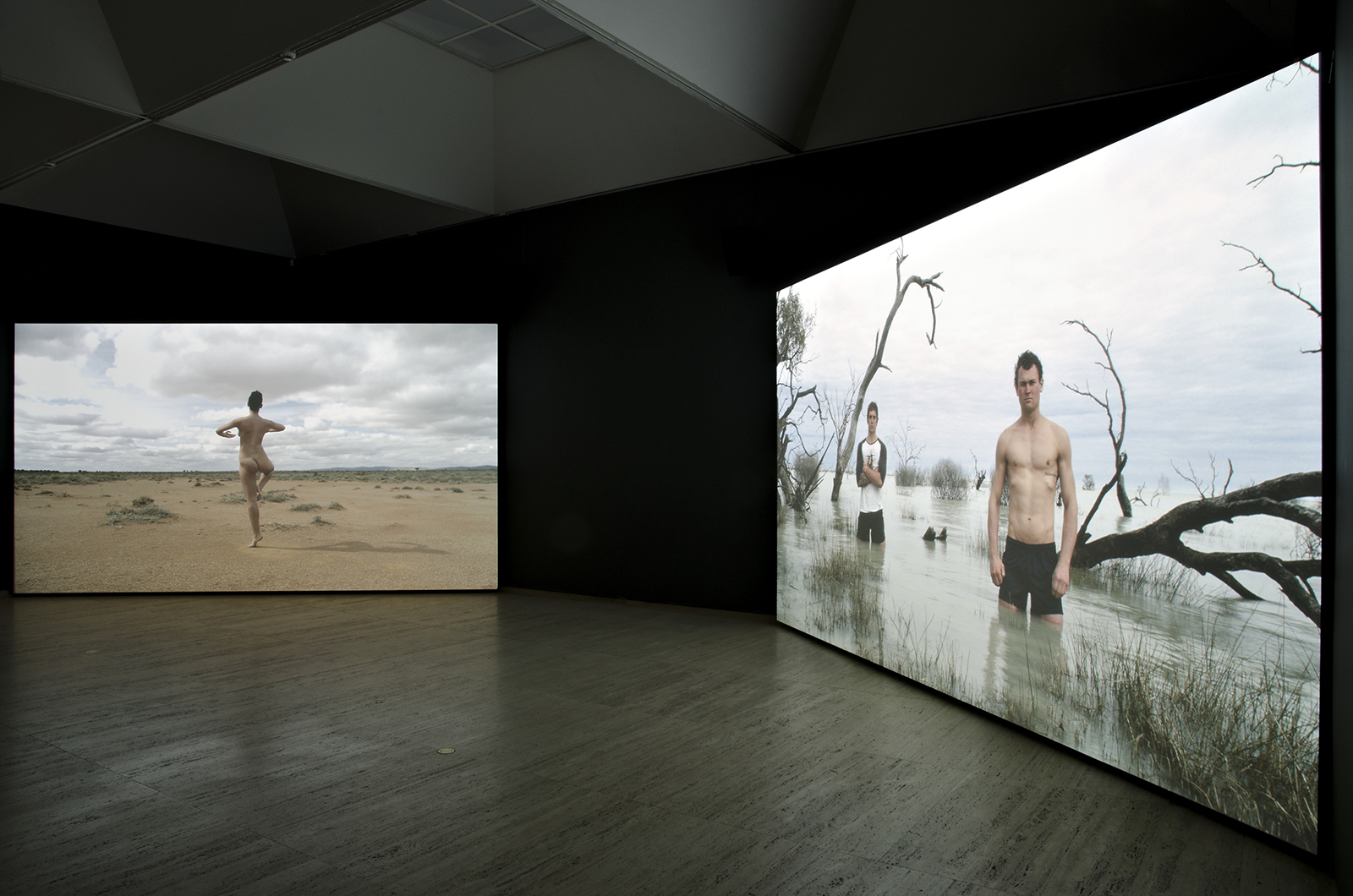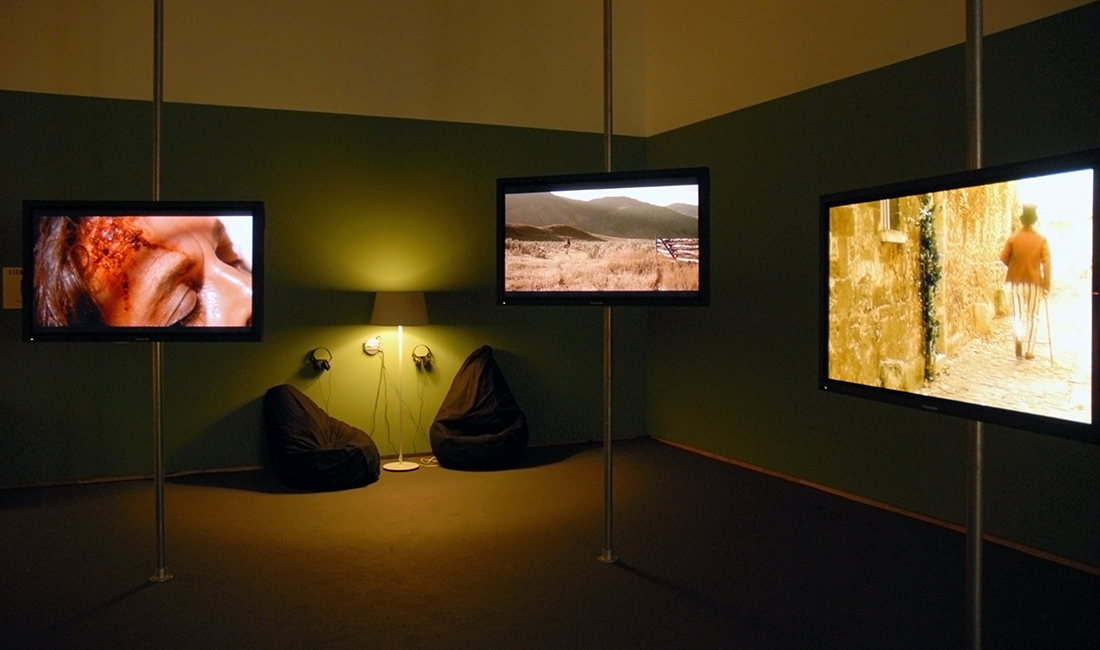Loops in the work of Omer Fast
and other contemporary artists
In Omer Fast’s 2011 video Five Thousand Feet is the Best, the fictional drone pilot memorably utters the following line: “The light at the end of the tunnel is just another tunnel”. This paradoxical quote reinforces the artwork’s foresighted political salience, as one of the first critical creative explorations of America’s drone program. The quote also presents an evocative circularity, intentionally upending the end point implied by the common use of this idiom. Loops, returns and repetitions permeate Fast’s practice frequently. While many of his early pieces display cyclical forms, including A Tank Translated (2002) and Spielberg’s List (2003), the hermetically looped structure has come to dominate his creative output from the mid-point of his career. Fast’s 2007 video De Grote Boodschap was his first to integrate a seamlessly circular structure with a plotted narrative construct. Since then, Fast has incorporated looped formats into a majority of his videos and installations, allowing him to develop complex, multi-layered understandings of temporality.
Omer Fast — “5,000 Feet is the Best”, 2011, digital video, color, sound, 30 min © Omer Fast
Fast has said that a key motivation for using loops is practical, since it allows viewers to enter gallery installations and pick up their stories at any point 1. Yet repetition also underpins the ways that his works critically address their audience. As he describes, repetition alludes to a “notion of criticality: that by seeing something again, slightly differently, we’re able to reflect on what’s shown or told” 2. This potential criticality that Fast speaks of is specifically facilitated by his integration of narrative within circular modes. As I will explore, Fast’s narratives always provide moments that escape their hermetic loops and extend outwards to confront how audiences consume such repeating images and stories—in art galleries, cinemas, and more broadly. In this sense, we can also appreciate how repetition and loops are important for many contemporary artists using video—as well as being central to the nature of film and time-based art.
In his 1979 essay “Cine-Repetitions” film scholar Raymond Bellour argues that “through the smallest to the largest differences between photograms, the repetition of the successive frames thus carries the coming into being of the film” 3. Bellour charts repetition as a constitutive characteristic of the cinema. We might say, to use well-worn art historical term, that repetition constitutes one of its “medium specificities”; cinema is defined and constructed by repetition, from its internal frame-by-frame progressions to its widest modes of distribution and presentation. For Bellour, repetition is a paradoxical feature, which endows cinema with its flexibility and productivity; as he observes, “repetition as a concept is both too general and yet very precise, which is its strength” 4.
Three decades on, as moving images have comprehensively moved into galleries, art theorist Boris Groys also approaches repetition as a defining characteristic of time-based art. For Groys, the exponential increase of sound and moving image artworks is arguably “the most characteristic aspect of museums of contemporary art [today]” 5. In a 2010 paper titled “Rules of Repetition”, Groys argues that repetition in time-based art exemplifies a particular sense of contemporary temporality, epitomised by the “loop” that artworks are subjected to when exhibited in gallery spaces. In contrast to Modernist narratives of progress and linear temporalities, Groys argues that contemporary Western culture is characterised by doubt and hesitation; it is “a prolonged, even potentially infinite period of delay”, a consequence of which is the valorisation of “wasted” time 6. For Groys, this wasted time is not unproductive, rather he sees it as “excessive” time that has not been absorbed into linear, historical processes and remains “forever unfinished and unsurpassed” 7. Time-based art reflects this contemporary condition because its requirement of looping overtly converts linear time into unending circular time.

Paul Pfeiffer, John 3:16, 2000, digital video loop, metal armature, LCD monitor,
DVD player, monitor: 5 1/2 x 6 1/2 x 36 in. (14 x 16.5 x 91.4 cm); video loop: 2:07.
© Paul Pfeiffer. Courtesy Paula Cooper Gallery, New York
Of course, showing a video on a loop is not a radical gesture in itself; nowadays it is a practical necessity in contemporary art spaces. Loops were an important formal device in experimental and structural filmmaking of the twentieth century 8. Early videotape, by contrast, was more portable than film but less malleable, and difficult to edit. Artists like Nam June Paik, Bruce Nauman and Dan Graham played with the feedback loops and closed-circuit systems of the transforming mass media culture of the 1960s and 1970s. As “frame-accurate” editing processes became commonly available for video, artists could incorporate sophisticated repeating and looping sequences, with Dara Birnbaum’s Technology/Transformation: Wonder Woman (1978–79) an early precursor 9. With the dominance of digital formats, looping has now become engrained in exhibition displays.
Excerpt: Paul Pfeiffer, Jerusalem (2014) from Artangel on Vimeo
© Paul Pfeiffer. Courtesy Paula Cooper Gallery, New York.
Despite being a practical requirement, loops also prove remarkably flexible in their creative possibilities. Short, mini-loops represent repetition at pace, condensing time and movement. They are present in the works of Paul Pfeiffer, who digitally compiles and morphs footage of sporting events like basketball games, producing short, semi-abstracted loops of physical action. In her series of videos Media Relations (2008–10), American artist McLean Fahnestock compresses the circularity of political rhetoric into repeating scenes, playing on the new media’s “sound-bite” culture. Ceal Floyer uses repeated “aural fragments” in her sound-installation ‘Til I Get it Right (2005), which samples and splices limited fragments of Tammy Wynette’s song of the same title, producing a haunting recitation of failure, resolve and continuity.
He him my husband Bill, 2008 from McLean Fahnestock on Vimeo.
McLean Fahnestock, He him my husband Bill, 2008. Video loop installed in color television, dresser; 1:30 minutes
Other artists loop more developed scenes, such as Rodney Graham in Vexation Island (1997) and City Self/Country Self (2000). Graham embeds cyclical returns into simple scenes—a desert-island pirate hit by a falling coconut, and a city dandy and rural peasant who cross paths antagonistically —which connect seamlessly and compactly. Aernout Mik, by contrast, stretches time by drawing out his loops into long, soundless scenarios; Mik’s scenes are like taut elastic, poised between further extension and a deferred moment of release or revelation. Some artists have ambitiously taken advantage of our ultimate geological and social loop, the 24-hour time period, such as Christian Marclay in The Clock (2010).
For Groys, artists like these who self-consciously incorporate loops in their work “thematize the process of repetitive waste of time and reflect the medium of time-based-art inside this medium itself” 10. It is in this sense that they reflect his view of contemporary temporality. However, when artworks like these are encountered in the gallery, often what is evoked is a sense of multiple temporalities at play, not exclusively the valorisation of “wasted time”. For example, in her dual-channel installation Cut Colony (2012), Australian artist Cate Consandine contrasts two perfect loops. Filmed in the Australian outback, the first video presents a naked female dancer performing a fouetté; the second depicts two men standing thigh-deep in an inland lake. Both videos are seamless loops, their “joins” are impossible to discern. Yet while the dancer’s cycle, spinning endlessly en pointe, is quickly recognisable, the static pose of the men means that their return-point is unclear, constantly deferred. While Cut Colony’s scenes are both cyclical returns, they evoke multiple temporalities, namely, perpetual action and perpetual stasis. The viewer, meanwhile, is caught between these temporal rhythms; as Consandine writes, “the internal rhythm of a loop acts on the body” 11.

Cate Consandine, Cut Colony, 2012. Dual-channel video installation, looped. Image courtesy of the artist.
Omer Fast also makes conceptual use of the loop, yet there is a complicating factor in his work that also reveals certain limitations to Groys’s analysis: narrative. In his argument, Groys assumes an idea of narrative that functions inescapably within linear, progressive temporalities 12. Naturally, exhibiting an artwork on a loop can disrupt its narrative logics, transforming and potentially frustrating its reception. Yet it is all too easily assumed that “linear” cause-and-effect narrative structures are diametrically opposed to repetition. In Groys’s schema, narrative is presumed to be incompatible with repetitive, non-progressive structures; when incorporated into a loop the “filmic narrative loses its power over our imagination”, and it “radically destroys any illusion of linear time” 13. Similarly, in a recent discussion on the topic, art historian Helen Westgeest states that “narrative cinema avoided repetitions, preferring a linear progression through unique events” 14. Yet returning to Bellour’s instructive text reminds us that even when cinematic narratives are integrated into linear cause-and-effect structures, they always proceed through repetitions and alternations 15. These repetitions, according to Bellour, “assign to the space of the film the form of a trajectory at once progressive and circular; between a first event and a second one repeating it” 16.
Fast’s videos abound with competing temporalities and multiple levels of reality, yet he does not achieve this by avoiding narrative and its linear implications. By contrast, the multiple temporalities initiated are precisely because of his use of narrative. When artists like Fast use developed narratives in looped gallery installations, they immediately create distinct points in time for the viewer, even if that time is represented as circular. The experience of the artwork is inescapably structured by the first moment of the story that is encountered. The ways that Fast “connects” his loops are always seamless; at the same time they are moments of rupture, when the reality of the circularity hits the viewer. As the video loops back upon itself, at this moment the viewer is tacitly addressed and their viewing position potentially shifts, opening up space for critical reflection beyond the closed-cycle. These moments of “seamless rupture” become forceful and memorable because they are tied up in viewers’ understanding of both cyclical and linear temporal structures—or as Fast says, a “notion of time that is both dysfunctional and liberating” 17.
Fast’s looped videos offer viewers distinct points of entry, through narratives that progress through causes, actions and events. Yet his repetitive structures complicate our understanding of the significance, motivation and triggers of such events. Fast uses the internal quality of filmic narrative that Bellour identifies, whereby narrative never ceases “to be resolved on to itself … by partial effects of symmetry, of circularity and compression [which] constitute so many successive micro-resolutions”; while he nonetheless avoids the “major resolutions” that characterise much mainstream filmmaking 18. Fast’s multi-room installation Nostalgia (2009) is a developed example, especially the artwork’s final, single-channel video, which depicts a post-Apocalyptic scenario: Europe is a desolate wasteland, with fleeing refugees seeking asylum in prosperous African countries. Temporal fluidity is present on many levels; the post-Apocalyptic scenes are filled with outdated technologies and retro-styled art direction, suggesting an alternate past. However, its reversal of racial and political situations suggests an alternate future, in which familiar (and regrettably persistent) rhetoric around asylum seekers is confrontingly re-positioned. This utterly circular narrative is contrasted with a second, more dramatic storyline, with a comparatively linear trajectory. Depicting the passage of European migrants, this narrative comes to a conclusion of sorts, as border guards kill one asylum seeker. By weaving together diverse strands of narrative development and temporality, Nostalgia constructs a fictional scenario that nonetheless consistently reminds viewers of contemporary rhetoric and politics around global movements of refugees and the perils of seeking asylum.
Bordeaux Piece, Long Goobye installed at MAMCO Geneva 2015 from Claerbout Studio on Vimeo.
Bellour has long been a foresighted critic of video art practices; as early as 1983 he wrote that “fiction as narrative will inevitably become video’s permanent temptation … It is part of the whole process of re-defining the importance of image versus narrative” 19. Arguably, this relationship is still being negotiated and Fast is one of a number of artists who creatively integrate narrative and repetition into time-based works. Stan Douglas explores this across much of his practice, including his formative installation Win, Place or Show (1998), as do David Claerbout’s Bordeaux Piece (2004) and David Rosetzky’s How to Feel (2011), which all approach differentially repeated narratives and scenarios. Keren Cytter’s videos like Something Happened (2007) and Corrections (2013) are particularly compelling; she integrates more frantic repetitions and numerous internal loops into her scenes, while contrasting these against the more stable sense of linearity implied by her use of voice-over.
CORRECTIONS from keren cytter on Vimeo.
In recent works, Fast’s loops have shifted to also incorporate specifically repeated scenarios. These are seen in Five Thousand Feet, and even more so in Continuity. In the 2012 video, Continuity’s variations were largely confined to internal and familial settings, becoming almost claustrophobically repetitive. In expanding this work for his Present Continuous exhibition, first impressions of Continuity (Diptych) (2012–15) may appear as if Fast is “explaining” some of the narrative loose ends of his earlier video—such as the dramatisation of the marijuana-dealing baker. This is, however, not the case. Fast has taken what was a fairly simple loop and developed it into a truly möbius strip, literally adding (plot) twists but still avoiding closure. The source of the parents’ grief is never truly clarified, and the additional narrative strands create multiple internal loops, within its overarching circular structure.
For the viewer, remembering what happens in Continuity is difficult. Fast’s re-working makes more explicit some of the earlier piece’s underlying implications, particularly the suggestion that the alternating “Daniels” were callboys hired by the parents. But what Continuity (Diptych) also achieves, more subtly and I would argue more compellingly, is to expand its consideration of the nature of filmic continuity. Does it matter that I cannot recall which “Daniel” I met first, or the nature of their relationship to other characters? Certainly not, and recently, philosopher Jacques Rancière has positioned this as a quality of cinema more generally. Rancière proposes that “the films recomposed by our perceptions, feelings and words count for as much as the ones printed on the film itself” 20. In effect, Rancière argues that the “wholeness” of linear narrative is a necessary illusion. It is not that linear narration should be rejected, however its force is not as ingrained as we might assume. Equally significant is what and how viewers remember the cinematic experience: the fragments, the snippets, the “meanderings and returns” 21. In this sense the fragmented, looped structures of Fast and his contemporaries perhaps have deeper conceptual connections with traditional filmic forms than initially presumed, adding further intrigue to the complex, evolving relationships between art and cinema.
Kate Warren, 2015
References








